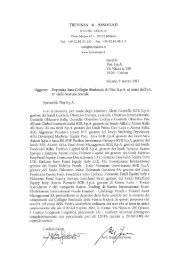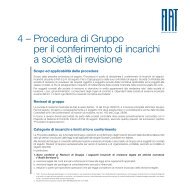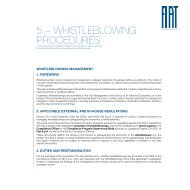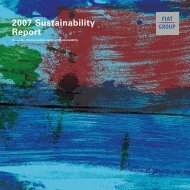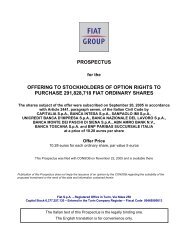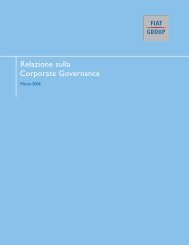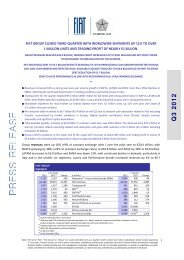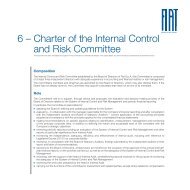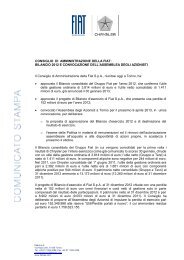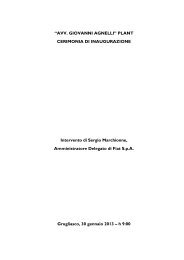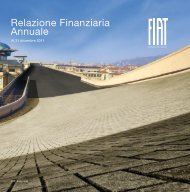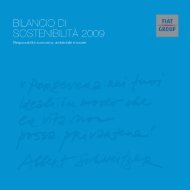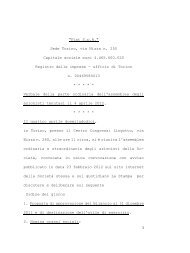annual report - FIAT SpA
annual report - FIAT SpA
annual report - FIAT SpA
You also want an ePaper? Increase the reach of your titles
YUMPU automatically turns print PDFs into web optimized ePapers that Google loves.
1234yf is a fluid and has different properties to R134a, which is a gas, including a lower refrigerant capacity,<br />
requiring optimization of the air-conditioning unit, and is highly flammable, necessitating a review of all system<br />
components and evaluation of the impacts on the work environment and filling systems.<br />
Advanced vehicles, materials and processes<br />
A central objective is to improve the eco-sustainability of vehicles and manufacturing process through the development<br />
of economically sustainable solutions for products and processes. This objective is shared at European level through<br />
the Green Cars Initiative, in which CRF participates actively as a member of the Industrial Advisory Group.<br />
The most significant achievements in this area during 2010 include:<br />
� Iveco Glider. This concept vehicle, presented by Iveco at the 2010 IAA International Motor Show in Hanover, is<br />
the fruit of a creative collaboration between Iveco and CRF. It is a new vehicle concept that offers high productivity<br />
and low environmental impact. The project focused on two key elements: energy efficiency and on-board comfort<br />
and functionality. In terms of energy efficiency, researchers developed a Kinetic Energy Recovery System (KERS),<br />
which enables the recovery of kinetic energy that would otherwise be dissipated as heat during braking, in addition<br />
to a thermodynamic system based on a Rankine cycle that recovers heat from the engine that would otherwise be<br />
dispersed through the exhaust and radiator. The Glider also generates renewable energy on-board using highly<br />
efficient and flexible solar panels that take up approximately 2 square meters on the roof of the cab and are<br />
capable of producing up to 2kWh of energy. Finally, any excess electric energy not used by the auxiliary systems is<br />
stored in an Auxiliary Energy Unit for use as an energy source when the vehicle is stationary. Research into<br />
significantly reducing aerodynamic drag, the use of new on-board energy management systems and the adoption<br />
of heat exchangers and low rolling resistance tires also contributed to the dramatic reduction in consumption and<br />
emissions. With regard to on-board comfort and functionality, the Glider was designed around the driver's specific<br />
needs with the cabin containing the latest technological solutions in terms of ergonomics, infomobility, lighting,<br />
climate control and space management.<br />
� Eco-compatible and recycled materials. In 2010, CRF further increased its commitment to solutions which<br />
address the environmental impacts (including CO2 emissions) from plastic components used in vehicles. Tests<br />
were carried out with biopolymer matrix compounds and recycled end-of-life materials reinforced with micronized<br />
natural fibers to enhance their structural characteristics, while also improving aesthetics.<br />
At the same time, CRF continued to monitor the percentage of recycled materials utilized in the Group's vehicles,<br />
increasing their use, particularly in non-aesthetic areas such as acoustic insulation. In 2010, analysis also<br />
continued into the impacts on the automotive sector of general environmental regulations, such as Classification<br />
Labelling & Packaging (CLP) and Registration Evaluation Authorisation and Restriction of Chemicals (REACH).<br />
For the second of these two regulations an investigation was conducted on Substances of Very High Concern<br />
(SVHCs) whose use may be restricted over the next few years. Alternatives are being tested for all SVHC<br />
materials currently used in the Group's vehicles. Finally, Life Cycle Assessments (LCAs) were conducted to<br />
evaluate the environmental impacts of the new fluid refrigerant HFO 1234yf throughout its entire lifecycle,<br />
comparing it with R134A and with CO2, and of phosphatization processes that could serve as alternatives to the<br />
current process based on nanocomposites derived from zirconium salts.<br />
� Highly energy-efficient production processes. In 2010, CRF continued with the Green Factories project. During<br />
the year, numerous activities focused on improvements in the energy efficiency of manufacturing processes. The<br />
most important of these projects were conducted at Fiat Group Automobiles' Cassino and Mirafiori plants and<br />
focused on development of kinetic energy recovery systems for industrial robots and testing of pilot installations of<br />
highly efficient lighting systems that provide increased light levels with reduced energy consumption. Measures to<br />
improve existing processes continued with the definition of a methodology to reduce energy consumed by<br />
mechanical processes. This area was also addressed by the FlexMech project, through the development of<br />
innovative down-sized, energy-saving actuators for application on machine tools. CRF also began development of<br />
methods and tools for the classification of industrial buildings by energy class to highlight their level of energy<br />
efficiency. In the area of environmental and economic sustainability, CRF participated in the Industrial Advisory<br />
Group of the European Factories of the Future initiative as team leader for development of a multi-year program on<br />
Sustainable Manufacturing, considered of primary strategic importance for the competitiveness of European<br />
manufacturing.<br />
� Micro and nanotechnologies for plant safety In the area of plant safety, Legislative Decree 81/2008 (health and<br />
safety in the workplace) introduced the obligation for employers to assess the risk of exposure to artificial optical<br />
radiation (AOR) for the first time in Italy. With more than a decade of experience in assessing display optics and<br />
new lighting sources, through its New Materials Scouting group, CRF was the first company to begin monitoring<br />
AOR levels at FGA's Mirafiori plant at the end of 2008 and is now the leader in optical radiation assessment,<br />
having conducted tests at more than 15 Fiat Group plants throughout Italy. This activity was necessary to comply<br />
with the legal obligation to assess the risk, but also contributed to a significant reduction in the risk of exposure to<br />
potentially hazardous sources in the factory and to improving the quality of the work environment.<br />
Report on Operations Research and Innovation<br />
29



